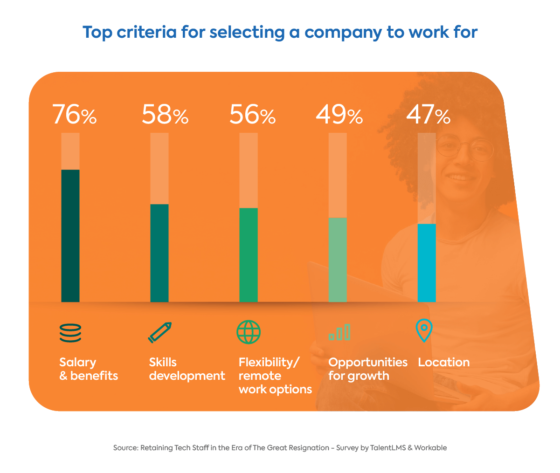9 types of workplace culture: evolve your company mindset
After three years (and a few post-pandemic months) of pouring through health, behavioral science and business research, analysts at W3RKWELL, a firm dedicated to employee wellbeing and culture, identified nine environmental (i.e., cultural) dimensions shown to influence employee wellness, performance and retention.

We’re in a world where employers struggle to attract talent, younger generations demand a focus on wellbeing and everyone from employees to executives are resigning due to stress.
We can no longer afford to ignore this opportunity to put big data into action.
We agree on the What and Why. Now — and for the foreseeable future — it’s about the How.
Armed with ample data and science on human behavior, we can thoughtfully design work experiences that fit today’s employees through clear, dedicated systems that preserve culture and wellbeing.
By integrating these nine dimensions into talent acquisition, onboarding, retention, performance rewards and values — to name a few — we can shift our mindset on what is truly possible in the modern era of work.
What is ‘culture’?
From a behavior analyst’s point of view, we know that we cannot change or measure what we cannot define. A first priority is to understand what exactly we mean when we use this term.
Culture is defined in terms of the environment in which an individual or group of individuals behaves, and the experiences that shape these behaviors over time. The environment includes policies, practices, daily experiences and leaders to ground-level employees.
How it’s created
For example, if a company states that it values wellbeing but does not allow employees to use their vacation time, this creates tension, confusion, stress and resentment. It also shifts the culture from what was originally told to employees and new hires (i.e., company values wellbeing) to what is experienced (i.e., the company does not, in fact, value wellbeing).
This leads to resignations, lost productivity and even an increase in lawsuits from employees. Research shows that employees who feel valued and cared for choose mediation over arbitration.
Culture is fluid
Group behavior shifts from one month, one hire, one merger to the next, which is known as behavior drift. Because these shifts are normal, it is imperative that companies are designed to hold culture and wellbeing strategies in place, with purpose, just as they approach business strategies, performance metrics and the like.
With these guiding categories in place, HR teams and leaders are exponentially better equipped to create and maintain cultures of care.
Contents
The Nine Dimensions of Culture
Let’s start by looking at the nine dimensions of workplace culture as defined by W3RKWELL:
1. Leadership
There exists a giant interpersonal gap between leaders and employees due to hierarchy, knowledge gaps, and archaic narratives about where leaders actually operate.
According to research from Stanford University, one of the top 10 variables that negatively affects employee wellbeing is perceived unfair decision-making at the top. Younger generations are demanding leaders who care about people and planet over (or as much as) profit.
“Strength” is experiencing a critical renaissance, changing ever so slowly from command-and-control to empathy, compassion and showing emotion.
In today’s world, leaders are no longer hidden away in ivory towers, protected by privacy and anonymity. Leaders are more visible than ever, and so are their actions, opinions and leadership moves.
Younger generations want to work for people to whom they can relate. They want to feel cared for, especially after a tumultuous few years of global strife and anxiety. Period.
Leadership Starter Checklist
- Are transparent systems in place to ensure that everyone, especially leadership, is held accountable for their actions?
- Do hiring and promotion metrics visibly outline qualifications for leadership roles, and do those metrics include measurable acts of empathy, value-alignment and service to others?
- Has your company developed systems to remove those who exhibit toxic or unethical behaviors in zero-tolerance moves?
Behavior trickles down – good, bad and ugly. By putting formal procedures into place, you can better ensure that future leaders will possess the values and behaviors employees want and need, instead of repeating ineffective, harmful behaviors from years past.
2. Autonomy
With office life disrupted during the pandemic, numerous studies took place to determine the extent to which productivity was affected while people were solely working from home. While remote work does possess its own set of distractions, these studies did not show a significant decline in performance.
In fact, some research showed the opposite, and it is hypothesized that control is the answer.
The Stanford research on wellbeing above also cites “lack of autonomy” as a top factor affecting employee health, which was confirmed with soaring societal stress when people were forced back into the office. Other research shows that increases in job strain were mediated with additional autonomy and control over task completion.
When we question whether remote or office work is best, the answer has more to do with work flexibility. The location matters less than the autonomy within those environments. If we are asking employees to be creative, work hard and find flow, we must create uninterrupted time and space for them to do so.
Essentially, the environment must support the behaviors we are encouraging.
Autonomy Starter Checklist
- Do remote or hybrid models allow employees the authority and freedom (also wellbeing influencers) to make choices about what environments produce optimal work?
- Has your company embedded behavioral nudges to keep employees asking “what do I need to create my best outcomes?”.
- Have moves been made to normalize away or OOO messages for employees doing focused work to avoid attention-crushing disruptions, reduce stress and increase the quality and quantity of work?
Organizations can take a hint from the Copenhagen company, Krukow, who designed a client’s office furniture to be lifted to the ceiling at 6 pm every day, or the dozens of companies currently experimenting with a four-day work week (current research is supportive).
Resource for additional information: Deep Work by Cal Newport
3. Performance and Growth
According to research from 2018, 86% of employees don’t feel trained to fluency in the jobs they’ve been hired to do. Moreover, if company culture does not adequately train its people, employees can face stressful lose-lose punishment contingencies.
This means that they receive negative feedback for jobs they were not adequately trained to perform in the first place, and the environment may also signal that with mistakes comes punishment. Employees then do what all humans do — they stay under the radar, avoid speaking up and continue to fail to meet expectations.
Many companies lack objective competency models and metrics for promotions that consider all skills, attitudes and responsibilities employees will face when performing their current role, or moving into their next role.
This adds a component of confusion to how, exactly, employees are to succeed. Failure to grow and succeed, or basic inertia, becomes one more stressful, though avoidable, variable to workplace culture.
Poor training and little opportunity for development then becomes a retention issue, as growth is consistently ranked as highly desired within the millennial and Gen Z workforce. Moreover, a sense of mastery at work has been correlated with positive health outcomes.

Performance and Growth Starter Checklist
- Has your company embedded science-supported learning strategies into training and development programs?
- Are employees are not only aware of and exposed to information, but can they demonstrate working with fluency — defined as accuracy plus speed minus hesitation?
- Are company pipelines in place to train and promote individuals or groups based on future roles (some organizations begin these pipelines the first week of onboarding)?
Fluency is shown to increase an individual’s feelings of competence and value, and can ensure your employees are under less stress at work. This model also integrates with performance issues. If employees have been trained to fluency but still struggle to meet goals or complete tasks, you can be more certain that the employee is experiencing a performance deficit (i.e., motivation issue or life challenges outside of work) rather than a skill deficit (i.e., being motivated but unable to carry out tasks at expectation).
4. Diversity, Equity and Inclusion
This dimension has sub-dimensions – legal, moral, organizational and societal – that go beyond the scope of this article, but this is one of the most necessary and critical in the wake of the BLM movement, #MeToo, abortion rights and the rise of Asian hate crimes during the pandemic. In addition, the LGBTQ+ community has greatly contributed to the conversation of the importance of diversity, equity and inclusion.
The last few years have unapologetically and energetically brought to light the harmful implicit bias, racism, sexism and homophobia that still exists in the workplace, despite larger acceptance and encouragement from parts of society.
According to a recent Bloomberg article, “the vast majority (86%) of employees feel people at their organization are not heard fairly or equally — and nearly half (47%) say that underrepresented voices remain undervalued by employers.”.
Paired with tokenism, an event in which a minority individual feels responsible for representing their entire group, this has serious health effects. According to an article in Health, tokenism and other forms of exclusion lead to high levels of stress, anxiety and depression.
Research tells us diversity, equity and inclusion leads to greater connection, morale, creativity, problem-solving and health, among other benefits – even for companies’ bottom lines. Millennials and Gen Z employees, along with many of their older peers, are looking for companies with diverse boards and workforces.
Companies must design mindful hiring practices, and reward systems and culture to honor this equitable evolution.
Related: Time for a DEI action plan: We’ll help you get there
DEI Starter Checklist
- Does your company avoid making assumptive, cringe-worthy decisions on how to honor diversity in your company and instead create spaces for open, honest communication?
- Are the viewpoints and experiences of diverse employees honored in meetings through asking, learning and understanding? What is done with this information?
- Are spaces available to source opinions and gather viewpoints on the work experiences, suggestions, unique barriers and cultural practices of diverse employees?
Have all teams – HR to finance to operations- educated on sensitive, respectful approaches to all groups represented at the company?
If your company is struggling for a starting point, consider a network dedicated to how the work environment may be modified for differently-abled or neurodiverse individuals, or how Black or LGBTQ+ individuals prefer to celebrate dedicated holidays like Juneteenth or Pride month.
5. Social Impact
More than 70% of millennials want their employers to focus on supporting societal or environmental issues.
As Larry Fink, CEO of BlackRock, stated in a past annual letter, “Companies must benefit all of their stakeholders, including shareholders, employees, customers and the communities in which they operate”. Purpose and meaning, along with mission-centered impact that serves the greater good, have been positively correlated with engagement and positive emotions at work.
Social Impact Starter Checklist
- Do employers work with leadership to gain information on truthful, active charitable contributions, volunteer days, service-oriented projects or company-wide preservation projects?
- Does the company contribute in some way to people or planet, such as using compostable utensils or partnerships with climate change organizations?
- If these efforts exist, are they mentioned during interviews? Are opportunities for involvement present in marketing, on social media, etc?
Belonging and connection (additional wellbeing influencers) are fostered here as well, contributing to employee loyalty and happiness.
6. Risk for burnout
This previously cloudy phenomena is now clearly defined in three components: physical exhaustion, performance decline and cynicism.
Behaviors that lead to burnout include working longer hours than desired for weeks or months, working outside expected working hours, failing to use entire allotted PTO, missing personal commitments to meet work expectations, and not taking advantage of flexible work arrangements (presumably because the environment demands an in-office hustle culture despite the lack of evidence supporting this).
This year, 63% of employees and 73% of C-suite executives said their companies do not allow time to disconnect or take their entire earned vacation time. This works against what we know to be true about retaining and preserving the wellbeing and performance of a company’s most precious resource — it’s people.
Burnout Starter Checklist
- Do the vast majority of employees take their full earned vacation time? If not, might there be underlying punishment contingencies that prevent people from doing so, such as the fear they will be perceived as less dedicated?
- Are systems in place that measure and immediately address burnout, such as a weekly survey? Consider: what is done with this information?
- When an employee experiences a significant level of one, two or all three burnout components, are they directly served and supported in a systematic, predictable way?
The typical reaction to these benefits – that employees will unnecessarily take advantage of them – has not been proven true in the research. In fact, it is mostly shown that employees who have access to these types of wellbeing supports perform better and remain at the company for longer than those who do not.
Research from Project Time Off also showed that the majority of people who earn promotions take at least 10 days of vacation a year, surpassing their peers who do not get promoted.
7. Authenticity and Psychological Safety
Psychological safety has soared to the top of company culture discussions as we more closely discuss harmful leadership behaviors, authenticity and workplace mental health.
Employees are showing up in droves to share that they do not feel safe at work due to harassment or a toxic work culture. When we synthesize this anecdotal data, the bottom line is clear: the modern workplace must embrace and encourage feelings of safety, belonging and acceptance.
This has become a zero-tolerance issue driven by younger generations who have a high sense of justice, and seemingly avoided by older generations who entered the workforce with a more staunch boundary between personal and professional.
Authenticity and Psychological Safety Starter Checklist
- Are visible efforts made to identify and remove narcissistic leaders and/or end overt and covert cultures of bullying and exclusion?
- Does the company represent and include all individuals represented at the company (i.e., pronouns, gender, sexual orientation, etc)?
- Do explicit company messaging and practices exist around psychological safety, including content from the experiences of current employees, and is this included during the interview and onboarding process?
This piece of culture is important to get right from the beginning, as it is extremely difficult to rebuild trust once employees feel insecure in their work culture.
8. Stress
This is an obvious category in regards to organizational culture and employee wellbeing. However, the numbers are shocking.
73% of employees regularly experience psychological symptoms caused by stress. Companies spend more than $300 billion per year on healthcare and work days as a result of workplace stress.
In a recent Deloitte study, nearly 70% of C-Suite executives are considering leaving their jobs for one that better supports their wellbeing. According to a Gallup report, 85% of employees state they are not engaged or actively disengaged at work.
Stress Starter Checklist
- Does the daily environment make modifications to reduce unnecessary stress (e.g., scheduled break times, nixing signs of hustle culture, open space in the day to take advantage of company benefits)?
- Does the company place the burden of stress management solely on the shoulders of employees (e.g., asking people to spend valuable time and effort on ameliorating the pressures their own workplaces have evoked)?
- Is the company riddled with chaos and unrealistic expectations, expecting employees to “just keep up”?
The pandemic era has undoubtedly propelled stress and anxiety to historic levels. However, this has provided a silver lining opportunity for companies to make meaningful moves, showing employees they are seen, heard and cared for.
9. Meaningful Relationships and Connection
Despite most post-pandemic studies showing the decline of mental and physical health across industries, the same or complementary studies show that we grossly overestimate how everyone else is doing.
The belief that “personal is not professional” is unfortunately still holding strong among leaders and managers, and many feel ill-equipped or hesitant to truly connect, receive and listen to one another while at work.
However, research shows that when leaders encourage and embrace the emotions each of us inherently possess, it can lead to improved team relationships and connection.
The longest-running study on health and happiness, the Harvard Adult study, consistently shows that meaningful relationships (i.e., quality, not quantity) is the single biggest predictor of health and happiness as we get older.
Meaningful Relationships and Connection Starter Checklist
- Is guidance provided to help managers and leaders feel comfortable showing empathy, vulnerability and compassion in daily behaviors, while also preserving their boundaries?
- Are top leaders present beyond yearly retreats or annual meetings?
- Is there space set aside for employees at all levels to truly connect, beyond Zoom happy hours or other outside-work events?
Consider what it would mean for your people to be more genuinely connected. Go deeper into what truly beings us together. Creating connection does not necessarily mean spending resources on retreats and events, it simply means relaxing into the new way of work and valuing it instead of siloing our human sides away — while we all fake a professional smile.
Build a healthy workplace culture
Culture is complex but, as we can see, not impossible to tackle. A strong purpose and dedicated team on the front end is very likely to lead to effective, sustainable, even profitable results in the long-term. We simply have to be willing to take what we know, and use it.
For more information on how to measure the nine dimensions of culture, visit W3RKWELL’s website.
Gianna Biscontini is a behavior scientist, lifestyle design coach, author and founder of the cultural analytics company, W3RKWELL.




